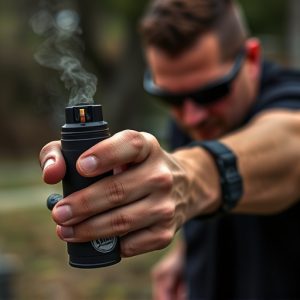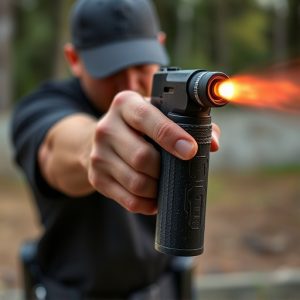Mastering Pepper Spray Defense: Neutralization Techniques and Future Innovations
Civilian-grade pepper spray, a personal defense tool used by law enforcement and civilians, relies o…….
Civilian-grade pepper spray, a personal defense tool used by law enforcement and civilians, relies on capsaicin to temporarily disable attackers. Its effectiveness is enhanced by propellants and stabilizers. In case of exposure, immediate shelter, water flushing, and neutralizing agents are crucial for safety. Future developments should focus on eco-friendly formulations, advanced delivery systems, and smart technology for improved protection against pepper spray on the face and beyond.
“Uncover the power of civilian-grade pepper defense spray—a versatile self-defense tool gaining popularity. This article delves into the science behind its components and effectiveness, offering insights into how it works against aggressive attackers. We explore practical strategies to quickly neutralize pepper spray on the face, ensuring users stay safe in potentially dangerous situations. Additionally, we examine long-term considerations and glimpse into future innovations that could revolutionize personal protection.”
- Understanding Civilian Grade Pepper Spray: Components and Effectiveness
- Strategies to Neutralize Pepper Spray on the Face: Quick Response Techniques
- Beyond Defense: Long-term Considerations and Future Innovations in Pepper Spray Protection
Understanding Civilian Grade Pepper Spray: Components and Effectiveness
Civilian-grade pepper spray is designed for personal protection and is widely used by law enforcement, security personnel, and civilians alike. Unlike military-grade options, it’s regulated for sale to the public, with varying concentrations and delivery systems. At its core, pepper spray consists of capsaicin, a natural chemical derived from chili peppers. This compound irritates the eyes, nose, throat, and skin, temporarily neutralizing Pepper Spray on Face and disorienting the user.
The effectiveness of civilian-grade pepper spray lies in its ability to create a significant enough irritation that an attacker pauses, allowing the target to escape or defend themselves further. However, its potency is carefully balanced to prevent harm or long-term injury. Key components beyond capsaicin include propellants (like CO2 or N2O) for delivery and sometimes additives to enhance stability or extend range. Understanding these components and their effects is crucial in harnessing the spray’s power effectively while ensuring user safety.
Strategies to Neutralize Pepper Spray on the Face: Quick Response Techniques
In the event of exposure to civilian-grade pepper spray, a quick response is crucial to minimize its effectiveness. The first step is to immediately seek a safe location and remove any clothing or accessories that may have come into contact with the spray. This includes washing your face with water to flush out as much of the irritant as possible. Do not rub your eyes or face, as this can spread the spray further, causing more discomfort and potential damage.
Once in a safe space, apply a neutralizing agent like an over-the-counter eye wash or a mixture of baking soda and water to help soothe the affected area. Take deep breaths to control coughing or breathing difficulties, and consider using a humidifier or steam from a hot shower to aid in clearing your sinuses. It’s important to stay calm and avoid panicking, as this can cloud your judgment and impair your ability to think clearly.
Beyond Defense: Long-term Considerations and Future Innovations in Pepper Spray Protection
In addition to neutralizing pepper spray on the face, future innovations in pepper spray protection should focus on long-term considerations. One key area is the development of more environmentally friendly and sustainable formulations. Current pepper sprays often contain harmful chemicals that can persist in the environment, posing risks to ecosystems and wildlife. Biodegradable alternatives could significantly reduce these impacts while maintaining effectiveness.
Moreover, advancements in delivery systems and technology are necessary. Improved spray patterns, increased range, and longer-lasting effects could enhance safety for individuals in various situations. Integrating smart sensors and AI algorithms into pepper spray devices might also enable users to track usage, expiration dates, and even predict optimal deployment times based on environmental factors. These innovations aim to go beyond neutralizing pepper spray on the face, offering comprehensive protection solutions tailored to modern needs.
Civilian-grade pepper spray, while an effective self-defense tool, can be neutralized with swift action. Understanding its components and effectiveness is key, as is knowing how to respond quickly to minimize its impact. Beyond immediate defense, considering long-term strategies and future innovations in pepper spray protection can further enhance personal safety. Remember, knowledge and preparation are essential tools for neutralizing pepper spray on the face and staying protected.


